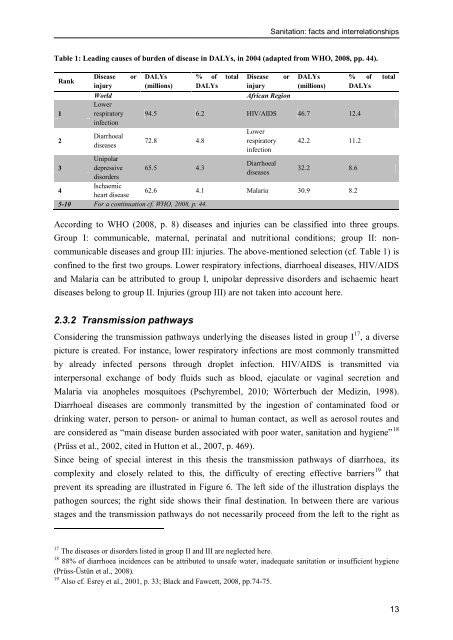Economic Effects of Sustainable Sanitation - SuSanA
Economic Effects of Sustainable Sanitation - SuSanA
Economic Effects of Sustainable Sanitation - SuSanA
You also want an ePaper? Increase the reach of your titles
YUMPU automatically turns print PDFs into web optimized ePapers that Google loves.
<strong>Sanitation</strong>: facts and interrelationships<br />
Table 1: Leading causes <strong>of</strong> burden <strong>of</strong> disease in DALYs, in 2004 (adapted from WHO, 2008, pp. 44).<br />
Rank<br />
Disease or<br />
injury<br />
DALYs<br />
(millions)<br />
% <strong>of</strong> total<br />
DALYs<br />
Disease or<br />
injury<br />
DALYs<br />
(millions)<br />
World<br />
Lower<br />
African Region<br />
1 respiratory<br />
infection<br />
94.5 6.2 HIV/AIDS 46.7 12.4<br />
2<br />
Diarrhoeal<br />
diseases<br />
72.8 4.8<br />
Lower<br />
respiratory<br />
infection<br />
42.2 11.2<br />
3<br />
Unipolar<br />
depressive<br />
disorders<br />
65.5 4.3<br />
Diarrhoeal<br />
diseases<br />
32.2 8.6<br />
4<br />
Ischaemic<br />
heart disease<br />
62.6 4.1 Malaria 30.9 8.2<br />
5-10 For a continuation cf. WHO, 2008, p. 44.<br />
% <strong>of</strong> total<br />
DALYs<br />
According to WHO (2008, p. 8) diseases and injuries can be classified into three groups.<br />
Group I: communicable, maternal, perinatal and nutritional conditions; group II: non-<br />
communicable diseases and group III: injuries. The above-mentioned selection (cf. Table 1) is<br />
confined to the first two groups. Lower respiratory infections, diarrhoeal diseases, HIV/AIDS<br />
and Malaria can be attributed to group I, unipolar depressive disorders and ischaemic heart<br />
diseases belong to group II. Injuries (group III) are not taken into account here.<br />
2.3.2 Transmission pathways<br />
Considering the transmission pathways underlying the diseases listed in group I 17 , a diverse<br />
picture is created. For instance, lower respiratory infections are most commonly transmitted<br />
by already infected persons through droplet infection. HIV/AIDS is transmitted via<br />
interpersonal exchange <strong>of</strong> body fluids such as blood, ejaculate or vaginal secretion and<br />
Malaria via anopheles mosquitoes (Pschyrembel, 2010; Wörterbuch der Medizin, 1998).<br />
Diarrhoeal diseases are commonly transmitted by the ingestion <strong>of</strong> contaminated food or<br />
drinking water, person to person- or animal to human contact, as well as aerosol routes and<br />
are considered as ―main disease burden associated with poor water, sanitation and hygiene‖ 18<br />
(Prüss et al., 2002, cited in Hutton et al., 2007, p. 469).<br />
Since being <strong>of</strong> special interest in this thesis the transmission pathways <strong>of</strong> diarrhoea, its<br />
complexity and closely related to this, the difficulty <strong>of</strong> erecting effective barriers 19 that<br />
prevent its spreading are illustrated in Figure 6. The left side <strong>of</strong> the illustration displays the<br />
pathogen sources; the right side shows their final destination. In between there are various<br />
stages and the transmission pathways do not necessarily proceed from the left to the right as<br />
17 The diseases or disorders listed in group II and III are neglected here.<br />
18 88% <strong>of</strong> diarrhoea incidences can be attributed to unsafe water, inadequate sanitation or insufficient hygiene<br />
(Prüss-Üstün et al., 2008).<br />
19 Also cf. Esrey et al., 2001, p. 33; Black and Fawcett, 2008, pp.74-75.<br />
13

















